
Fortification
Encyclopedia
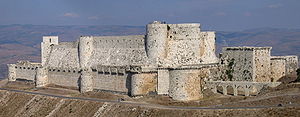
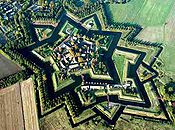

Military
A military is an organization authorized by its greater society to use lethal force, usually including use of weapons, in defending its country by combating actual or perceived threats. The military may have additional functions of use to its greater society, such as advancing a political agenda e.g...
construction
Construction
In the fields of architecture and civil engineering, construction is a process that consists of the building or assembling of infrastructure. Far from being a single activity, large scale construction is a feat of human multitasking...
s and building
Building
In architecture, construction, engineering, real estate development and technology the word building may refer to one of the following:...
s designed for defence
Defense (military)
Defense has several uses in the sphere of military application.Personal defense implies measures taken by individual soldiers in protecting themselves whether by use of protective materials such as armor, or field construction of trenches or a bunker, or by using weapons that prevent the enemy...
in war
War
War is a state of organized, armed, and often prolonged conflict carried on between states, nations, or other parties typified by extreme aggression, social disruption, and usually high mortality. War should be understood as an actual, intentional and widespread armed conflict between political...
fare and military base
Military base
A military base is a facility directly owned and operated by or for the military or one of its branches that shelters military equipment and personnel, and facilitates training and operations. In general, a military base provides accommodations for one or more units, but it may also be used as a...
s. Humans have constructed defensive works for many thousands of years, in a variety of increasingly complex designs. The term is derived from the Latin
Latin
Latin is an Italic language originally spoken in Latium and Ancient Rome. It, along with most European languages, is a descendant of the ancient Proto-Indo-European language. Although it is considered a dead language, a number of scholars and members of the Christian clergy speak it fluently, and...
fortis ("strong") and facere ("to make").
Nomenclature
Many military installations are known as forts, although they are not always fortified. Larger forts may class as fortresses; smaller ones formerly often bore the name of fortalices. The word fortification can also refer to the practice of improving an area's defence with defensive works. City wallsDefensive wall
A defensive wall is a fortification used to protect a city or settlement from potential aggressors. In ancient to modern times, they were used to enclose settlements...
are fortifications but not necessarily called fortresses.
The art of setting out a military camp or constructing a fortification traditionally classifies as castramentation, since the time of the Roman legion
Roman legion
A Roman legion normally indicates the basic ancient Roman army unit recruited specifically from Roman citizens. The organization of legions varied greatly over time but they were typically composed of perhaps 5,000 soldiers, divided into maniples and later into "cohorts"...
s. The art
Art
Art is the product or process of deliberately arranging items in a way that influences and affects one or more of the senses, emotions, and intellect....
/science
Science
Science is a systematic enterprise that builds and organizes knowledge in the form of testable explanations and predictions about the universe...
of laying siege
Siege
A siege is a military blockade of a city or fortress with the intent of conquering by attrition or assault. The term derives from sedere, Latin for "to sit". Generally speaking, siege warfare is a form of constant, low intensity conflict characterized by one party holding a strong, static...
to a fortification and of destroying it has the popular name of siegecraft or 'siege warfare' and the formal name of poliorcetics. In some texts this latter term also applies to the art of building a fortification.
Fortification is usually divided into two branches, namely permanent fortification and field fortification. Permanent fortifications are erected at leisure, with all the resources that a state can supply of constructive and mechanical
Mechanical engineering
Mechanical engineering is a discipline of engineering that applies the principles of physics and materials science for analysis, design, manufacturing, and maintenance of mechanical systems. It is the branch of engineering that involves the production and usage of heat and mechanical power for the...
skill, and are built of enduring materials. Field fortifications are extemporized by troops in the field, perhaps assisted by such local labour and tools as may be procurable and with materials that do not require much preparation, such as earth
Soil
Soil is a natural body consisting of layers of mineral constituents of variable thicknesses, which differ from the parent materials in their morphological, physical, chemical, and mineralogical characteristics...
, brushwood and light timber
Timber
Timber may refer to:* Timber, a term common in the United Kingdom and Australia for wood materials * Timber, Oregon, an unincorporated community in the U.S...
, or sandbags (see sangar).
There is also an intermediate branch known as semi-permanent fortification. This is employed when in the course of a campaign it becomes desirable to protect some locality with the best imitation of permanent defences that can be made in a short time, ample resources and skilled civilian labour being available.
Castle
Castle
A castle is a type of fortified structure built in Europe and the Middle East during the Middle Ages by European nobility. Scholars debate the scope of the word castle, but usually consider it to be the private fortified residence of a lord or noble...
s are fortifications which are regarded as being distinct from the generic fort or fortress in that it describes a residence of a monarch
Monarch
A monarch is the person who heads a monarchy. This is a form of government in which a state or polity is ruled or controlled by an individual who typically inherits the throne by birth and occasionally rules for life or until abdication...
or noble
Nobility
Nobility is a social class which possesses more acknowledged privileges or eminence than members of most other classes in a society, membership therein typically being hereditary. The privileges associated with nobility may constitute substantial advantages over or relative to non-nobles, or may be...
and commands a specific defensive territory.
Ancient
From very early history to modern times, wallsDefensive wall
A defensive wall is a fortification used to protect a city or settlement from potential aggressors. In ancient to modern times, they were used to enclose settlements...
have been a necessity for many cities. Uruk
Uruk
Uruk was an ancient city of Sumer and later Babylonia, situated east of the present bed of the Euphrates river, on the ancient dry former channel of the Euphrates River, some 30 km east of modern As-Samawah, Al-Muthannā, Iraq.Uruk gave its name to the Uruk...
in ancient Sumer
Sumer
Sumer was a civilization and historical region in southern Mesopotamia, modern Iraq during the Chalcolithic and Early Bronze Age....
(Mesopotamia
Mesopotamia
Mesopotamia is a toponym for the area of the Tigris–Euphrates river system, largely corresponding to modern-day Iraq, northeastern Syria, southeastern Turkey and southwestern Iran.Widely considered to be the cradle of civilization, Bronze Age Mesopotamia included Sumer and the...
) is one of the world's oldest known walled cities. The Ancient Egyptians also built fortresses on the frontiers of the Nile Valley to protect against invaders from its neighbouring territories. Many of the fortifications of the ancient world were built with mud brick, leaving many no more than mounds of dirt for today's archaeologists.

Some settlements in the Indus Valley Civilization
Indus Valley Civilization
The Indus Valley Civilization was a Bronze Age civilization that was located in the northwestern region of the Indian subcontinent, consisting of what is now mainly modern-day Pakistan and northwest India...
were also fortified. By about 3500 B.C., hundreds of small farming villages dotted the Indus floodplain. Many of these settlements had fortifications and planned streets. The stone and mud brick houses of Kot Diji
Kot Diji
The ancient site at Kot Diji was the forerunner of the Indus Civilization. The people of this site lived about 3000 BCE. The remains consist of two parts; the citadel area on high ground , and outer area...
were clustered behind massive stone flood dykes and defensive walls, for neighbouring communities bickered constantly about the control of prime agricultural land. Mundigak (c. 2500 B.C.) in present day south-east Afghanistan
Afghanistan
Afghanistan , officially the Islamic Republic of Afghanistan, is a landlocked country located in the centre of Asia, forming South Asia, Central Asia and the Middle East. With a population of about 29 million, it has an area of , making it the 42nd most populous and 41st largest nation in the world...
has defensive walls and square bastions of sun dried bricks.

Babylon
Babylon was an Akkadian city-state of ancient Mesopotamia, the remains of which are found in present-day Al Hillah, Babil Province, Iraq, about 85 kilometers south of Baghdad...
was one of the most famous cities of the ancient world, especially as a result of the building program of Nebuchadnezzar
Nebuchadnezzar
Nebuchadnezzar was the name of several kings of Babylonia.* Nebuchadnezzar I, who ruled the Babylonian Empire in the 12th century BC* Nebuchadnezzar II , the Babylonian ruler mentioned in the biblical Book of Daniel...
, who expanded the walls and built the Ishtar Gate
Ishtar Gate
The Ishtar Gate was the eighth gate to the inner city of Babylon. It was constructed in about 575 BC by order of King Nebuchadnezzar II on the north side of the city....
.
Exceptions were few—notably, ancient Sparta
Sparta
Sparta or Lacedaemon, was a prominent city-state in ancient Greece, situated on the banks of the River Eurotas in Laconia, in south-eastern Peloponnese. It emerged as a political entity around the 10th century BC, when the invading Dorians subjugated the local, non-Dorian population. From c...
and ancient Rome
Rome
Rome is the capital of Italy and the country's largest and most populated city and comune, with over 2.7 million residents in . The city is located in the central-western portion of the Italian Peninsula, on the Tiber River within the Lazio region of Italy.Rome's history spans two and a half...
did not have walls for a long time, choosing to rely on their militaries for defence instead. Initially, these fortifications were simple constructions of wood and earth, which were later replaced by mixed constructions of stones piled on top of each other without mortar
Mortar (masonry)
Mortar is a workable paste used to bind construction blocks together and fill the gaps between them. The blocks may be stone, brick, cinder blocks, etc. Mortar becomes hard when it sets, resulting in a rigid aggregate structure. Modern mortars are typically made from a mixture of sand, a binder...
.
In Central Europe
Central Europe
Central Europe or alternatively Middle Europe is a region of the European continent lying between the variously defined areas of Eastern and Western Europe...
, the Celts built large fortified settlements known as oppida
Oppidum
Oppidum is a Latin word meaning the main settlement in any administrative area of ancient Rome. The word is derived from the earlier Latin ob-pedum, "enclosed space," possibly from the Proto-Indo-European *pedóm-, "occupied space" or "footprint."Julius Caesar described the larger Celtic Iron Age...
, whose walls seem partially influenced by those built in the Mediterranean. The fortifications were continuously being expanded and improved.
In ancient Greece
Ancient Greece
Ancient Greece is a civilization belonging to a period of Greek history that lasted from the Archaic period of the 8th to 6th centuries BC to the end of antiquity. Immediately following this period was the beginning of the Early Middle Ages and the Byzantine era. Included in Ancient Greece is the...
, large stone walls had been built in Mycenaean Greece
Mycenaean Greece
Mycenaean Greece was a cultural period of Bronze Age Greece taking its name from the archaeological site of Mycenae in northeastern Argolis, in the Peloponnese of southern Greece. Athens, Pylos, Thebes, and Tiryns are also important Mycenaean sites...
, such as the ancient site of Mycenae
Mycenae
Mycenae is an archaeological site in Greece, located about 90 km south-west of Athens, in the north-eastern Peloponnese. Argos is 11 km to the south; Corinth, 48 km to the north...
(famous for the huge stone blocks of its 'cyclopean' walls). In classical era Greece
Greece
Greece , officially the Hellenic Republic , and historically Hellas or the Republic of Greece in English, is a country in southeastern Europe....
, the city of Athens
Athens
Athens , is the capital and largest city of Greece. Athens dominates the Attica region and is one of the world's oldest cities, as its recorded history spans around 3,400 years. Classical Athens was a powerful city-state...
built a long set of parallel stone walls called the Long Walls
Long Walls
The Long Walls , in Ancient Greece, were walls built from a city to its port, providing a secure connection to the sea even during times of siege. Although long walls were built at several locations in Greece—Corinth and Megara being two of the best known examples—the phrase "long...
that reached their guarded seaport at Piraeus
Piraeus
Piraeus is a city in the region of Attica, Greece. Piraeus is located within the Athens Urban Area, 12 km southwest from its city center , and lies along the east coast of the Saronic Gulf....
.
Large tempered earth (i.e. rammed earth
Rammed earth
Rammed earth, also known as taipa , tapial , and pisé , is a technique for building walls using the raw materials of earth, chalk, lime and gravel. It is an ancient building method that has seen a revival in recent years as people seek more sustainable building materials and natural building methods...
) walls were built in ancient China since the Shang Dynasty
Shang Dynasty
The Shang Dynasty or Yin Dynasty was, according to traditional sources, the second Chinese dynasty, after the Xia. They ruled in the northeastern regions of the area known as "China proper" in the Yellow River valley...
(c. 1600-1050 BC), as the capital at ancient Ao had enormous walls built in this fashion (see siege
Siege
A siege is a military blockade of a city or fortress with the intent of conquering by attrition or assault. The term derives from sedere, Latin for "to sit". Generally speaking, siege warfare is a form of constant, low intensity conflict characterized by one party holding a strong, static...
for more info). Although stone walls were built in China during the Warring States (481-221 BC), mass conversion to stone architecture did not begin in earnest until the Tang Dynasty
Tang Dynasty
The Tang Dynasty was an imperial dynasty of China preceded by the Sui Dynasty and followed by the Five Dynasties and Ten Kingdoms Period. It was founded by the Li family, who seized power during the decline and collapse of the Sui Empire...
(618-907 AD).
In terms of China's longest and most impressive fortification, the Great Wall had been built since the Qin Dynasty
Qin Dynasty
The Qin Dynasty was the first imperial dynasty of China, lasting from 221 to 207 BC. The Qin state derived its name from its heartland of Qin, in modern-day Shaanxi. The strength of the Qin state was greatly increased by the legalist reforms of Shang Yang in the 4th century BC, during the Warring...
(221-207 BC), although its present form was mostly an engineering feat and remodelling of the Ming Dynasty
Ming Dynasty
The Ming Dynasty, also Empire of the Great Ming, was the ruling dynasty of China from 1368 to 1644, following the collapse of the Mongol-led Yuan Dynasty. The Ming, "one of the greatest eras of orderly government and social stability in human history", was the last dynasty in China ruled by ethnic...
(1368-1644 AD). The large walls of Pingyao
Pingyao
Pingyao is a Chinese city and county in central Shanxi province, China. It lies about 715 km from Beijing and 80 km from the provincial capital, Taiyuan. During the Qing Dynasty, Pingyao was a financial center of China...
serve as one example. Likewise, the famous walls of the Forbidden City
Forbidden City
The Forbidden City was the Chinese imperial palace from the Ming Dynasty to the end of the Qing Dynasty. It is located in the middle of Beijing, China, and now houses the Palace Museum...
in Beijing
Beijing
Beijing , also known as Peking , is the capital of the People's Republic of China and one of the most populous cities in the world, with a population of 19,612,368 as of 2010. The city is the country's political, cultural, and educational center, and home to the headquarters for most of China's...
were established in the early 15th century by the Yongle Emperor
Yongle Emperor
The Yongle Emperor , born Zhu Di , was the third emperor of the Ming Dynasty of China from 1402 to 1424. His Chinese era name Yongle means "Perpetual Happiness".He was the Prince of Yan , possessing a heavy military base in Beiping...
.
The Romans
Ancient Rome
Ancient Rome was a thriving civilization that grew on the Italian Peninsula as early as the 8th century BC. Located along the Mediterranean Sea and centered on the city of Rome, it expanded to one of the largest empires in the ancient world....
fortified their cities with massive, mortar-bound stone walls. The most famous of these are the largely extant Aurelian Walls
Aurelian Walls
The Aurelian Walls is a line of city walls built between 271 and 275 in Rome, Italy, during the reign of the Roman Emperors Aurelian and Probus....
of Rome
Rome
Rome is the capital of Italy and the country's largest and most populated city and comune, with over 2.7 million residents in . The city is located in the central-western portion of the Italian Peninsula, on the Tiber River within the Lazio region of Italy.Rome's history spans two and a half...
and the Theodosian Walls of Constantinople
Constantinople
Constantinople was the capital of the Roman, Eastern Roman, Byzantine, Latin, and Ottoman Empires. Throughout most of the Middle Ages, Constantinople was Europe's largest and wealthiest city.-Names:...
, together with partial remains elsewhere. These are mostly city gates, like the Porta Nigra
Porta Nigra
The Porta Nigra is a large Roman city gate in Trier, Germany. It is today the largest Roman city gate north of the Alps and has been designated a World Heritage Site....
in Trier
Trier
Trier, historically called in English Treves is a city in Germany on the banks of the Moselle. It is the oldest city in Germany, founded in or before 16 BC....
or Newport Arch
Newport Arch
Newport Arch is the name given to the remains of a 3rd century Roman gate in the city of Lincoln, Lincolnshire. It is reputedly the oldest arch in the United Kingdom still used by traffic.- History :...
in Lincoln
Lincoln, Lincolnshire
Lincoln is a cathedral city and county town of Lincolnshire, England.The non-metropolitan district of Lincoln has a population of 85,595; the 2001 census gave the entire area of Lincoln a population of 120,779....
.
Hadrian's Wall
Hadrian's Wall
Hadrian's Wall was a defensive fortification in Roman Britain. Begun in AD 122, during the rule of emperor Hadrian, it was the first of two fortifications built across Great Britain, the second being the Antonine Wall, lesser known of the two because its physical remains are less evident today.The...
was built by the Roman Empire
Roman Empire
The Roman Empire was the post-Republican period of the ancient Roman civilization, characterised by an autocratic form of government and large territorial holdings in Europe and around the Mediterranean....
across the width of what is now northern England
Northern England
Northern England, also known as the North of England, the North or the North Country, is a cultural region of England. It is not an official government region, but rather an informal amalgamation of counties. The southern extent of the region is roughly the River Trent, while the North is bordered...
following a visit by Roman Emperor Hadrian
Hadrian
Hadrian , was Roman Emperor from 117 to 138. He is best known for building Hadrian's Wall, which marked the northern limit of Roman Britain. In Rome, he re-built the Pantheon and constructed the Temple of Venus and Roma. In addition to being emperor, Hadrian was a humanist and was philhellene in...
(AD 76–138) in AD 122.
Medieval
Roman fortCastra
The Latin word castra, with its singular castrum, was used by the ancient Romans to mean buildings or plots of land reserved to or constructed for use as a military defensive position. The word appears in both Oscan and Umbrian as well as in Latin. It may have descended from Indo-European to Italic...
s and hill fort
Hill fort
A hill fort is a type of earthworks used as a fortified refuge or defended settlement, located to exploit a rise in elevation for defensive advantage. They are typically European and of the Bronze and Iron Ages. Some were used in the post-Roman period...
s were the main antecedents of castle
Castle
A castle is a type of fortified structure built in Europe and the Middle East during the Middle Ages by European nobility. Scholars debate the scope of the word castle, but usually consider it to be the private fortified residence of a lord or noble...
s in Europe
Europe
Europe is, by convention, one of the world's seven continents. Comprising the westernmost peninsula of Eurasia, Europe is generally 'divided' from Asia to its east by the watershed divides of the Ural and Caucasus Mountains, the Ural River, the Caspian and Black Seas, and the waterways connecting...
, which emerged in the 9th century in the Carolingian Empire
Carolingian Empire
Carolingian Empire is a historiographical term which has been used to refer to the realm of the Franks under the Carolingian dynasty in the Early Middle Ages. This dynasty is seen as the founders of France and Germany, and its beginning date is based on the crowning of Charlemagne, or Charles the...
.
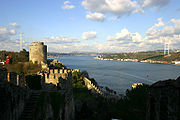
Early Middle Ages
The Early Middle Ages was the period of European history lasting from the 5th century to approximately 1000. The Early Middle Ages followed the decline of the Western Roman Empire and preceded the High Middle Ages...
saw the creation of some towns built around castles. These cities were only rarely protected by simple stone walls and more usually by a combination of both walls and ditch
Ditch
A ditch is usually defined as a small to moderate depression created to channel water.In Anglo-Saxon, the word dïc already existed and was pronounced 'deek' in northern England and 'deetch' in the south. The origins of the word lie in digging a trench and forming the upcast soil into a bank...
es. From the 12th century AD hundreds of settlements of all sizes were founded all across Europe, which very often obtained the right of fortification soon afterwards.
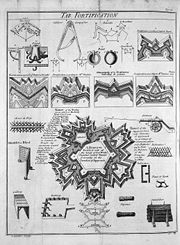

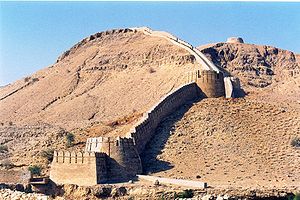
Eastern Europe
Eastern Europe is the eastern part of Europe. The term has widely disparate geopolitical, geographical, cultural and socioeconomic readings, which makes it highly context-dependent and even volatile, and there are "almost as many definitions of Eastern Europe as there are scholars of the region"...
, were founded precisely for this purpose during the period of Eastern Colonisation
Ostsiedlung
Ostsiedlung , also called German eastward expansion, was the medieval eastward migration and settlement of Germans from modern day western and central Germany into less-populated regions and countries of eastern Central Europe and Eastern Europe. The affected area roughly stretched from Slovenia...
. These cities are easy to recognise due to their regular layout and large market spaces. The fortifications of these settlements were continuously improved to reflect the current level of military development.
During the Renaissance era, the Venetians raised great walls around cities threatened by the Ottoman empire
Ottoman Empire
The Ottoman EmpireIt was usually referred to as the "Ottoman Empire", the "Turkish Empire", the "Ottoman Caliphate" or more commonly "Turkey" by its contemporaries...
. The finest examples are, among others, in Nicosia
Nicosia
Nicosia from , known locally as Lefkosia , is the capital and largest city in Cyprus, as well as its main business center. Nicosia is the only divided capital in the world, with the southern and the northern portions divided by a Green Line...
(Cyprus) and Chania
Chania
Chaniá , , also transliterated Chania, Hania, and Xania, older form Chanea and Venetian Canea, Ottoman Turkish خانيه Hanya) is the second largest city of Crete and the capital of the Chania peripheral unit...
(Crete), and they still stand, to this day.
Early Modern
Medieval-style fortifications were largely made obsolete by the arrival of cannonCannon
A cannon is any piece of artillery that uses gunpowder or other usually explosive-based propellents to launch a projectile. Cannon vary in caliber, range, mobility, rate of fire, angle of fire, and firepower; different forms of cannon combine and balance these attributes in varying degrees,...
s on the 14th century battle
Battle
Generally, a battle is a conceptual component in the hierarchy of combat in warfare between two or more armed forces, or combatants. In a battle, each combatant will seek to defeat the others, with defeat determined by the conditions of a military campaign...
field. Fortifications in the age of blackpowder evolved into much lower structures with greater use of ditches and earth
Earthworks (engineering)
Earthworks are engineering works created through the moving or processing of quantities of soil or unformed rock.- Civil engineering use :Typical earthworks include roads, railway beds, causeways, dams, levees, canals, and berms...
rampart
Defensive wall
A defensive wall is a fortification used to protect a city or settlement from potential aggressors. In ancient to modern times, they were used to enclose settlements...
s that would absorb and disperse the energy of cannon fire. Walls exposed to direct cannon fire were very vulnerable, so were sunk into ditches fronted by earth slopes.
This placed a heavy emphasis on the geometry
Geometry
Geometry arose as the field of knowledge dealing with spatial relationships. Geometry was one of the two fields of pre-modern mathematics, the other being the study of numbers ....
of the fortification to allow defensive cannonry interlocking fields of fire to cover all approaches to the lower and thus more vulnerable walls.
The evolution of this new style of fortification can be seen in transitional forts such as Sarzanello in North West Italy which was built between 1492 and 1502. Sarzanello consists of both crenallated walls with towers typical of the medieval period but also has a ravelin
Ravelin
A ravelin is a triangular fortification or detached outwork, located in front of the innerworks of a fortress...
like angular gun platform screening one of the curtain walls which is protected from flanking fire from the towers of the main part of the fort.
Fortifications also extended in depth, with protected batteries for defensive cannonry, to allow them to engage attacking cannon to keep them at a distance and prevent them bearing directly on the vulnerable walls.
The result was star shaped fortifications
Star fort
A star fort, or trace italienne, is a fortification in the style that evolved during the age of gunpowder, when cannon came to dominate the battlefield, and was first seen in the mid-15th century in Italy....
with tier upon tier of hornworks and bastion
Bastion
A bastion, or a bulwark, is a structure projecting outward from the main enclosure of a fortification, situated in both corners of a straight wall , facilitating active defence against assaulting troops...
s, of which Bourtange illustrated to the right is an excellent example. There are also extensive fortifications from this era in the Nordic
Northern Europe
Northern Europe is the northern part or region of Europe. Northern Europe typically refers to the seven countries in the northern part of the European subcontinent which includes Denmark, Estonia, Latvia, Lithuania, Norway, Finland and Sweden...
states and in Britain
Great Britain
Great Britain or Britain is an island situated to the northwest of Continental Europe. It is the ninth largest island in the world, and the largest European island, as well as the largest of the British Isles...
, the fortifications of Berwick-upon-Tweed
Berwick-upon-Tweed
Berwick-upon-Tweed or simply Berwick is a town in the county of Northumberland and is the northernmost town in England, on the east coast at the mouth of the River Tweed. It is situated 2.5 miles south of the Scottish border....
and the harbour archipelago
Archipelago
An archipelago , sometimes called an island group, is a chain or cluster of islands. The word archipelago is derived from the Greek ἄρχι- – arkhi- and πέλαγος – pélagos through the Italian arcipelago...
of Suomenlinna
Suomenlinna
Suomenlinna, until 1918 Viapori , or Sveaborg , is an inhabited sea fortress built on six islands , and which now forms part of the city of Helsinki, the capital of Finland.Suomenlinna is a UNESCO World Heritage site and popular with both tourists and locals, who...
at Helsinki
Helsinki
Helsinki is the capital and largest city in Finland. It is in the region of Uusimaa, located in southern Finland, on the shore of the Gulf of Finland, an arm of the Baltic Sea. The population of the city of Helsinki is , making it by far the most populous municipality in Finland. Helsinki is...
being fine examples.
19th Century
The arrival of explosive shells in the 19th century led to yet another stage in the evolution of fortification. Star fortStar fort
A star fort, or trace italienne, is a fortification in the style that evolved during the age of gunpowder, when cannon came to dominate the battlefield, and was first seen in the mid-15th century in Italy....
s of the cannon era did not fare well against the effects of high explosive and the intricate arrangements of bastions, flanking batteries and the carefully constructed lines of fire for the defending cannon could be rapidly disrupted by explosive shells.
Worse, the large open ditches surrounding forts of this type were an integral part of the defensive scheme, as was the covered way at the edge of the counter scarp. The ditch was extremely vulnerable to bombardment with explosive shells.
In response, military engineers evolved the polygonal
Polygonal fort
A polygonal fort is a fortification in the style that evolved around the middle of the nineteenth century, in response to the development of powerful explosive shells....
style of fortification. The ditch became deep and vertically sided, cut directly into the native rock or soil, laid out as a series of straight lines creating the central fortified area that gives this style of fortification its name.
Wide enough to be an impassable barrier for attacking troops, but narrow enough to be a difficult target for enemy shellfire, the ditch was swept by fire from defensive blockhouses set in the ditch as well as firing positions cut into the outer face of the ditch itself.
The profile of the fort became very low indeed, surrounded outside the ditch by a gently sloping open area so as to eliminate possible cover for enemy forces, while the fort itself provided a minimal target for enemy fire. The entrypoint became a sunken gatehouse in the inner face of the ditch, reached by a curving ramp that gave access to the gate via a rolling bridge that could be withdrawn into the gatehouse.
Traditional fortification however continued to be applied by European armies engaged in warfare in colonies established in Africa against lightly armed attackers from amongst the indigenous population. A relatively small number of defenders in a fort impervious to iron-age weaponry could hold out against high odds, the only constraint being the supply of ammunition.
Much of the fort moved underground, with deep passages and tunnel
Tunnel
A tunnel is an underground passageway, completely enclosed except for openings for egress, commonly at each end.A tunnel may be for foot or vehicular road traffic, for rail traffic, or for a canal. Some tunnels are aqueducts to supply water for consumption or for hydroelectric stations or are sewers...
s to connect the blockhouse
Blockhouse
In military science, a blockhouse is a small, isolated fort in the form of a single building. It serves as a defensive strong point against any enemy that does not possess siege equipment or, in modern times, artillery...
s and firing points in the ditch to the fort proper, with magazines
Magazine (artillery)
Magazine is the name for an item or place within which ammunition is stored. It is taken from the Arabic word "makahazin" meaning "warehouse".-Ammunition storage areas:...
and machine rooms deep under the surface.
The guns however, were often mounted in open emplacements and protected only by a parapet
Parapet
A parapet is a wall-like barrier at the edge of a roof, terrace, balcony or other structure. Where extending above a roof, it may simply be the portion of an exterior wall that continues above the line of the roof surface, or may be a continuation of a vertical feature beneath the roof such as a...
- both in order to keep a lower profile and also because experience with guns in closed casemate
Casemate
A casemate, sometimes rendered casement, is a fortified gun emplacement or armored structure from which guns are fired. originally a vaulted chamber in a fortress.-Origin of the term:...
s had seen them put out of action by rubble as their own casemates were collapsed around them.
20th and 21st Centuries
SteelSteel
Steel is an alloy that consists mostly of iron and has a carbon content between 0.2% and 2.1% by weight, depending on the grade. Carbon is the most common alloying material for iron, but various other alloying elements are used, such as manganese, chromium, vanadium, and tungsten...
-and-concrete
Concrete
Concrete is a composite construction material, composed of cement and other cementitious materials such as fly ash and slag cement, aggregate , water and chemical admixtures.The word concrete comes from the Latin word...
fortifications were common during the 19th and early 20th centuries. However the advances in modern warfare since World War I
World War I
World War I , which was predominantly called the World War or the Great War from its occurrence until 1939, and the First World War or World War I thereafter, was a major war centred in Europe that began on 28 July 1914 and lasted until 11 November 1918...
have made large-scale fortifications obsolete in most situations. Only underground bunker
Bunker
A military bunker is a hardened shelter, often buried partly or fully underground, designed to protect the inhabitants from falling bombs or other attacks...
s are still able to provide some protection in modern wars. Many historical fortifications were demolished during the modern age, but a considerable number survive as popular tourist destinations and prominent local landmark
Landmark
This is a list of landmarks around the world.Landmarks may be split into two categories - natural phenomena and man-made features, like buildings, bridges, statues, public squares and so forth...
s today.
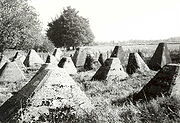
- The ever escalating power, speed, and reach of artillery and air power meant that almost any target that could be located could be destroyed, if sufficient force were massed against it. As such, the more resources a defender devoted to reinforcing a fortification, the more combat power that fortification justified being devoted to destroying it, if the fortification's destruction was demanded by an attacker's strategy. By 1950, nuclear weaponNuclear weaponA nuclear weapon is an explosive device that derives its destructive force from nuclear reactions, either fission or a combination of fission and fusion. Both reactions release vast quantities of energy from relatively small amounts of matter. The first fission bomb test released the same amount...
s were capable of destroying entire cities, and produced dangerous radiationRadiationIn physics, radiation is a process in which energetic particles or energetic waves travel through a medium or space. There are two distinct types of radiation; ionizing and non-ionizing...
. This led to the creation of civilian nuclear air raid shelters. In the late 20th century, bunker busterBunker busterA bunker buster is a bomb designed to penetrate hardened targets or targets buried deep underground.-Germany:Röchling shells were bunker-busting artillery shells, developed by German engineer August Cönders, based on the theory of increasing sectional density to improve penetration.They were tested...
s were being used against bunkers. - The second weakness of permanent fortification was its very permanency. Because of this it was often easier to go around a fortification and, with the rise of mobile warfare in the beginning of World War IIWorld War IIWorld War II, or the Second World War , was a global conflict lasting from 1939 to 1945, involving most of the world's nations—including all of the great powers—eventually forming two opposing military alliances: the Allies and the Axis...
, this became a viable offensive choice. When a defensive line was too extensive to be entirely bypassed, massive offensive might could be massed against one part of the line allowing a breakthrough, after which the rest of the line could be bypassed. Such was the fate of the many defensive lines built before and during World War IIWorld War IIWorld War II, or the Second World War , was a global conflict lasting from 1939 to 1945, involving most of the world's nations—including all of the great powers—eventually forming two opposing military alliances: the Allies and the Axis...
, such as the Siegfried LineSiegfried LineThe original Siegfried line was a line of defensive forts and tank defences built by Germany as a section of the Hindenburg Line 1916–1917 in northern France during World War I...
, the Stalin LineStalin LineThe Stalin Line was a line of fortifications along the western border of the Soviet Union. Work began on the system in the 1920s to protect the USSR against attacks from the West. The line was made up of concrete bunkers and gun emplacements, somewhat similar but less elaborate than the Maginot...
and the Atlantic WallAtlantic WallThe Atlantic Wall was an extensive system of coastal fortifications built by Nazi Germany between 1942 and 1944 along the western coast of Europe as a defense against an anticipated Allied invasion of the mainland continent from Great Britain.-History:On March 23, 1942 Führer Directive Number 40...
. Note that this was not the case of the Maginot LineMaginot LineThe Maginot Line , named after the French Minister of War André Maginot, was a line of concrete fortifications, tank obstacles, artillery casemates, machine gun posts, and other defences, which France constructed along its borders with Germany and Italy, in light of its experience in World War I,...
, designed to force the Germans to pass through Belgium and that has fully achieved its political and strategic role.
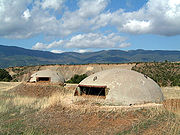
Trench warfare
Trench warfare is a form of occupied fighting lines, consisting largely of trenches, in which troops are largely immune to the enemy's small arms fire and are substantially sheltered from artillery...
which dominated World War I
World War I
World War I , which was predominantly called the World War or the Great War from its occurrence until 1939, and the First World War or World War I thereafter, was a major war centred in Europe that began on 28 July 1914 and lasted until 11 November 1918...
, these defences were more temporary in nature. This was an advantage because since it was less extensive it formed a less obvious target for enemy force to be directed against.
If sufficient power were massed against one point to penetrate it, the forces based there could be withdrawn and the line could be re-established relatively quickly. Instead of a supposedly impenetrable defensive line, such fortifications emphasized defence in depth
Defence in depth
Defence in depth is a military strategy; it seeks to delay rather than prevent the advance of an attacker, buying time and causing additional casualties by yielding space...
, so that as defenders were forced to pull back or were overrun, the lines of defenders behind them could take over the defence.
Because the mobile offensives practised by both sides usually focused on avoiding the strongest points of a defensive line, these defences were usually relatively thin and spread along the length of a line. The defence was usually not equally strong throughout however.
The strength of the defensive line in an area varied according to how rapidly an attacking force could progress in the terrain that was being defended—both the terrain the defensive line was built on and the ground behind it that an attacker might hope to break out into. This was both for reasons of the strategic value of the ground, and its defensive value.
This was possible because while offensive tactics were focused on mobility, so were defensive tactics. The dug in defences consisted primarily of infantry and antitank guns. Defending tanks and tank destroyers would be concentrated in mobile "Fire Brigades" behind the defensive line. If a major offensive was launched against a point in the line, mobile reinforcements would be sent to reinforce that part of the line that was in danger of failing.
Thus the defensive line could be relatively thin because the bulk of the fighting power of the defenders was not concentrated in the line itself but rather in the mobile reserves. A notable exception to this rule was seen in the defensive lines at the Battle of Kursk
Battle of Kursk
The Battle of Kursk took place when German and Soviet forces confronted each other on the Eastern Front during World War II in the vicinity of the city of Kursk, in the Soviet Union in July and August 1943. It remains both the largest series of armored clashes, including the Battle of Prokhorovka,...
during World War II
World War II
World War II, or the Second World War , was a global conflict lasting from 1939 to 1945, involving most of the world's nations—including all of the great powers—eventually forming two opposing military alliances: the Allies and the Axis...
, where German
Germany
Germany , officially the Federal Republic of Germany , is a federal parliamentary republic in Europe. The country consists of 16 states while the capital and largest city is Berlin. Germany covers an area of 357,021 km2 and has a largely temperate seasonal climate...
forces deliberately attacked into the strongest part of the Soviet defences seeking to crush them utterly.
The terrain
Terrain
Terrain, or land relief, is the vertical and horizontal dimension of land surface. When relief is described underwater, the term bathymetry is used...
that was being defended was of primary importance because open terrain that tanks could move over quickly made possible rapid advances into the defenders' rear areas that were very dangerous to the defenders. Thus such terrain had to be defended at all cost.
In addition, since in theory the defensive line only had to hold out long enough for mobile reserves to reinforce it, terrain that did not permit rapid advance could be held more weakly because the enemy's advance into it would be slower, giving the defenders more time to reinforce that point in the line. For example, the battle of the Hurtgen Forest in Germany
Germany
Germany , officially the Federal Republic of Germany , is a federal parliamentary republic in Europe. The country consists of 16 states while the capital and largest city is Berlin. Germany covers an area of 357,021 km2 and has a largely temperate seasonal climate...
during the closing stages of World War II
World War II
World War II, or the Second World War , was a global conflict lasting from 1939 to 1945, involving most of the world's nations—including all of the great powers—eventually forming two opposing military alliances: the Allies and the Axis...
is an excellent example of how impassable terrain could be used to the defenders' advantage.
After World War II, ICBMs capable of reaching much of the way around the world (and rockets capable of reaching the Moon
Moon
The Moon is Earth's only known natural satellite,There are a number of near-Earth asteroids including 3753 Cruithne that are co-orbital with Earth: their orbits bring them close to Earth for periods of time but then alter in the long term . These are quasi-satellites and not true moons. For more...
and other nearby celestial bodies) were developed, and so speed became an essential characteristic of the strongest militaries and defenses. Missile silos were developed, so missiles could be fired from the middle of a country and hit cities and targets in another country, and airplanes (and air carriers) became major defenses and offensive weapons (leading to an expansion of the use of airports and airstrips as fortifications). Mobile defenses could be had underwater, too, in the form of nuclear submarine
Nuclear submarine
A nuclear submarine is a submarine powered by a nuclear reactor . The performance advantages of nuclear submarines over "conventional" submarines are considerable: nuclear propulsion, being completely independent of air, frees the submarine from the need to surface frequently, as is necessary for...
s capable of firing missiles. Some bunkers in the mid to late 20th century came to be buried deep inside mountains and prominent rocks, such as Gibraltar
Gibraltar
Gibraltar is a British overseas territory located on the southern end of the Iberian Peninsula at the entrance of the Mediterranean. A peninsula with an area of , it has a northern border with Andalusia, Spain. The Rock of Gibraltar is the major landmark of the region...
and Cheyenne Mountain
Cheyenne Mountain
Cheyenne Mountain is a mountain located just outside the southwest side of Colorado Springs, Colorado, U.S., and is home to the Cheyenne Mountain Air Force Station and its Cheyenne Mountain Directorate, formerly known as the Cheyenne Mountain Operations Center .Throughout the Cold War and...
. On the ground itself, minefields have been used as hidden defences in modern warfare, often remaining long after the wars that have produced them have ended.
Demilitarized zone
Demilitarized zone
In military terms, a demilitarized zone is an area, usually the frontier or boundary between two or more military powers , where military activity is not permitted, usually by peace treaty, armistice, or other bilateral or multilateral agreement...
s along borders are arguably another type of fortification, although a passive kind, providing a buffer between potentially hostile militaries.
Forts
.Forts in modern usage often refer to space set aside by governments for a permanent military facility; these often do not have any actual fortifications, and can have specializations (military barracks, administration, medical facilities, or intelligence). In the United States
United States
The United States of America is a federal constitutional republic comprising fifty states and a federal district...
usage, forts specifically refer to Army
Army
An army An army An army (from Latin arma "arms, weapons" via Old French armée, "armed" (feminine), in the broadest sense, is the land-based military of a nation or state. It may also include other branches of the military such as the air force via means of aviation corps...
fortifications; Marine Corps
Marine corps
A marine is a member of a force that specializes in expeditionary operations such as amphibious assault and occupation. The marines traditionally have strong links with the country's navy...
fortifications are referred to as camp
Military camp
A military camp or bivouac is a semi-permanent facility for the lodging of an army. Camps are erected when a military force travels away from a major installation or fort during training or operations, and often have the form of large campsites. In the Roman era the military camp had highly...
s.
However there are some modern fortifications that are referred to as forts. These are typically small semi permanent fortifications. In urban combat they are built by upgrading existing structures such as houses or public buildings. In field warfare they are often log, sandbag or gabion
Gabion
Gabions are cages, cylinders, or boxes filled with soil or sand that are used in civil engineering, road building, and military applications. For erosion control caged riprap is used. For dams or foundation construction, cylindrical metal structures are used...
type construction.
Such forts are typically only used in low level conflict, e.g., counterinsurgency conflicts or very low level conventional conflicts, e.g., the Indonesia–Malaysia confrontation saw the use of log forts for use by forward platoons and companies
Company (military unit)
A company is a military unit, typically consisting of 80–225 soldiers and usually commanded by a Captain, Major or Commandant. Most companies are formed of three to five platoons although the exact number may vary by country, unit type, and structure...
. The reason for this is that static above ground forts can not survive modern direct or indirect fire weapons larger than mortars, RPGs and small arms.
North America
In British North America, and subsequently in the frontiers of the United States, prior to the 20th century the term fort was increasingly used for any military base of operations regardless of how fortified it was. Military forts in the American Old WestAmerican Old West
The American Old West, or the Wild West, comprises the history, geography, people, lore, and cultural expression of life in the Western United States, most often referring to the latter half of the 19th century, between the American Civil War and the end of the century...
during the Indian Wars
Indian Wars
American Indian Wars is the name used in the United States to describe a series of conflicts between American settlers or the federal government and the native peoples of North America before and after the American Revolutionary War. The wars resulted from the arrival of European colonizers who...
were often lightly fortified enclosures with log or adobe
Adobe
Adobe is a natural building material made from sand, clay, water, and some kind of fibrous or organic material , which the builders shape into bricks using frames and dry in the sun. Adobe buildings are similar to cob and mudbrick buildings. Adobe structures are extremely durable, and account for...
walls. In many areas the term fort was used to refer to any European or U.S. outpost, military, para-military, or civilian, that was located in an undeveloped region. Many of these outposts were simply trading post
Trading post
A trading post was a place or establishment in historic Northern America where the trading of goods took place. The preferred travel route to a trading post or between trading posts, was known as a trade route....
s or a combination of a trading post and an Army post.
Some famous U.S. military forts included Fort Laramie and Fort Bridger
Fort Bridger
Fort Bridger was originally a 19th century fur trading outpost established in 1842 on Blacks Fork of the Green River and later a vital resupply point for wagon trains on the Oregon Trail, California Trail and Mormon Trail. The Army established a military post here in 1858 during the Utah War until...
on the Emigrant Trail
Emigrant Trail
The Emigrant Trails were the northern networks of overland wagon trails throughout the American West, used by emigrants from the eastern United States to settle lands west of the Interior Plains during the overland migrations of the mid-19th century...
and Bent's Fort on the Arkansas River.
Prisons and others
Fortifications designed to keep the inhabitants of a facility in rather than out can also be found, in prisons, concentration camps, and other such facilities, with supermaxSupermax
Supermax is the name used to describe "control-unit" prisons, or units within prisons, which represent the most secure levels of custody in the prison systems of certain countries...
es having some of the strongest of those. Those are covered in other articles, as most prisons and concentration camps are not primarily military forts (although forts, camps, and garrison towns have been used as prisons and/or concentration camps; see Theresienstadt, Guantanamo Bay, and the Tower of London
Tower of London
Her Majesty's Royal Palace and Fortress, more commonly known as the Tower of London, is a historic castle on the north bank of the River Thames in central London, England. It lies within the London Borough of Tower Hamlets, separated from the eastern edge of the City of London by the open space...
for examples).
See also
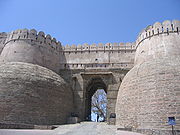

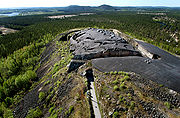
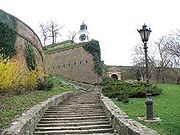
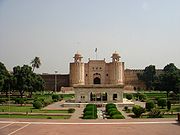

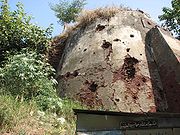
- Border fence
- CastraCastraThe Latin word castra, with its singular castrum, was used by the ancient Romans to mean buildings or plots of land reserved to or constructed for use as a military defensive position. The word appears in both Oscan and Umbrian as well as in Latin. It may have descended from Indo-European to Italic...
- CitadelCitadelA citadel is a fortress for protecting a town, sometimes incorporating a castle. The term derives from the same Latin root as the word "city", civis, meaning citizen....
- Defensive wallDefensive wallA defensive wall is a fortification used to protect a city or settlement from potential aggressors. In ancient to modern times, they were used to enclose settlements...
- Hesco bastionHesco bastionThe HESCO bastion is both a modern gabion used for flood control and military fortification and the name of the British company that developed it in the late 1980s. It is made of a collapsible wire mesh container and heavy duty fabric liner, and used as a temporary to semi-permanent dike or barrier...
- List of fortifications
- List of forts
Fort components
- AbatisAbatisAbatis, abattis, or abbattis is a term in field fortification for an obstacle formed of the branches of trees laid in a row, with the sharpened tops directed outwards, towards the enemy. The trees are usually interlaced or tied with wire...
- BanquetteBanquetteIn fortification, a banquette is a small foot path or elevated step along the inside of a rampart or parapet, by which the musketeers get up to view the counterscarp, or to fire on the enemies in the moat...
- Barbed wireBarbed wireBarbed wire, also known as barb wire , is a type of fencing wire constructed with sharp edges or points arranged at intervals along the strand. It is used to construct inexpensive fences and is used atop walls surrounding secured property...
, Razor wireRazor wireBarbed tape or razor wire is a mesh of metal strips with sharp edges whose purpose is to prevent passage by humans. The term "razor wire", through long usage, has generally been used to describe barbed tape products...
, Wire entanglement, and Wire obstacleWire obstacleIn the military science of fortification, wire obstacles are defensive obstacles made from barbed wire, barbed tape or concertina wire. They are designed to disrupt, delay and generally slow down an attacking enemy... - BartizanBartizanA bartizan or guerite is an overhanging, wall-mounted turret projecting from the walls of medieval fortifications from the early 14th century up to the 16th century. They protect a warder and enable him to see around him...
- BastionBastionA bastion, or a bulwark, is a structure projecting outward from the main enclosure of a fortification, situated in both corners of a straight wall , facilitating active defence against assaulting troops...
- BermBermA berm is a level space, shelf, or raised barrier separating two areas. Berm originates in the Middle Dutch and German berme and came into usage in English via French.- History :...
- CaponierCaponierA caponier is a type of fortification structure. The word originates from the French word "caponnière" - which strictly means capon-cote i.e. chickenhouse.The fire coming from the feature A caponier is a type of fortification structure. The word originates from the French word "caponnière" -...
- CasemateCasemateA casemate, sometimes rendered casement, is a fortified gun emplacement or armored structure from which guns are fired. originally a vaulted chamber in a fortress.-Origin of the term:...
- CurtainCastle Walls"Castle Walls" is a song by American rapper T.I., from his seventh studio album No Mercy. The song features Pop/R&B singer Christina Aguilera, and was produced by Alex da Kid....
- Czech hedgehogCzech hedgehogThe Czech hedgehog or ježek, was a static anti-tank obstacle defence made of angled iron deployed during World War II by various combatants....
- Defensive fighting positionDefensive fighting positionA defensive fighting position is a type of earthwork constructed in a military context, generally large enough to accommodate at least one person.- Terminology :...
(aka a "foxhole") - DitchDitchA ditch is usually defined as a small to moderate depression created to channel water.In Anglo-Saxon, the word dïc already existed and was pronounced 'deek' in northern England and 'deetch' in the south. The origins of the word lie in digging a trench and forming the upcast soil into a bank...
- EmbrasureEmbrasureIn military architecture, an embrasure is the opening in a crenellation or battlement between the two raised solid portions or merlons, sometimes called a crenel or crenelle...
- GlacisGlacisA glacis in military engineering is an artificial slope of earth used in late European fortresses so constructed as to keep any potential assailant under the fire of the defenders until the last possible moment...
- Gun turretGun turretA gun turret is a weapon mount that protects the crew or mechanism of a projectile-firing weapon and at the same time lets the weapon be aimed and fired in many directions.The turret is also a rotating weapon platform...
- KeepKeepA keep is a type of fortified tower built within castles during the Middle Ages by European nobility. Scholars have debated the scope of the word keep, but usually consider it to refer to large towers in castles that were fortified residences, used as a refuge of last resort should the rest of the...
- PalisadePalisadeA palisade is a steel or wooden fence or wall of variable height, usually used as a defensive structure.- Typical construction :Typical construction consisted of small or mid sized tree trunks aligned vertically, with no spacing in between. The trunks were sharpened or pointed at the top, and were...
- ParapetParapetA parapet is a wall-like barrier at the edge of a roof, terrace, balcony or other structure. Where extending above a roof, it may simply be the portion of an exterior wall that continues above the line of the roof surface, or may be a continuation of a vertical feature beneath the roof such as a...
- Pillbox
- PosternPosternA postern is a secondary door or gate, particularly in a fortification such as a city wall or castle curtain wall. Posterns were often located in a concealed location, allowing the occupants to come and go inconspicuously. In the event of a siege, a postern could act as a sally port, allowing...
- RavelinRavelinA ravelin is a triangular fortification or detached outwork, located in front of the innerworks of a fortress...
- RevetmentRevetmentRevetments, or revêtements , have a variety of meanings in architecture, engineering and art history. In stream restoration, river engineering or coastal management, they are sloping structures placed on banks or cliffs in such a way as to absorb the energy of incoming water...
- SandbagSandbagA sandbag is a sack made of hessian/burlap, polypropylene or other materials that is filled with sand or soil and used for such purposes as flood control, military fortification, shielding glass windows in war zones and ballast....
- Scarp and CounterscarpCounterscarpA scarp and a counterscarp are the inner and outer sides of a ditch used in fortifications. In permanent fortifications the scarp and counterscarp may be encased in stone...
- TurretTurretIn architecture, a turret is a small tower that projects vertically from the wall of a building such as a medieval castle. Turrets were used to provide a projecting defensive position allowing covering fire to the adjacent wall in the days of military fortification...
Types of forts and fortification
- Bastion fortress
- Blanket fortBlanket fortA blanket fort is a construction commonly made using blankets, bed sheets, pillows, and sofa cushions. It is also known as a couch fort, pillow fort or sheet fort....
- BlockhouseBlockhouseIn military science, a blockhouse is a small, isolated fort in the form of a single building. It serves as a defensive strong point against any enemy that does not possess siege equipment or, in modern times, artillery...
- BunkerBunkerA military bunker is a hardened shelter, often buried partly or fully underground, designed to protect the inhabitants from falling bombs or other attacks...
- CastleCastleA castle is a type of fortified structure built in Europe and the Middle East during the Middle Ages by European nobility. Scholars debate the scope of the word castle, but usually consider it to be the private fortified residence of a lord or noble...
- City wall
- Chinese city wallChinese city wallChinese city walls refer to civic defensive systems used to protect towns and cities in China in pre-modern times. The system consisted of walls, towers, and gates, which were often built to a uniform standard throughout the Empire....
- CompoundCompound (fortification)In military science, a compound is a type of fortification made up of walls or fences surrounding several buildings in the center of a large piece of land...
- DiaolouDiaolouThe Kaiping Diaolou are fortified multi-storey towers, generally made of reinforced concrete. These towers are located mainly in Kaiping County, Guangdong province, China...
- Fire support baseFire support baseA fire support base is a military encampment designed to provide indirect fire artillery fire support to infantry operating in areas beyond the normal range of direct fire support from their own base camps....
- Flak towerFlak towerFlak towers were 8 complexes of large, above-ground, anti-aircraft gun blockhouse towers constructed in the cities of Berlin , Hamburg , and Vienna from 1940 onwards....
- Grad, a Slavic wooden fortified settlement
- Hill fortHill fortA hill fort is a type of earthworks used as a fortified refuge or defended settlement, located to exploit a rise in elevation for defensive advantage. They are typically European and of the Bronze and Iron Ages. Some were used in the post-Roman period...
- Land batteryLand batteryA land battery is a special type of gun emplacement or anti-shipping naval interdiction fortification used in coastal defense to protect areas such as anchorages, harbors, and rivers...
- Martello towerMartello towerMartello towers are small defensive forts built in several countries of the British Empire during the 19th century, from the time of the Napoleonic Wars onwards....
- Medieval fortificationMedieval fortificationMedieval fortification is military methods of Medieval technology that covers the development of fortification construction and use in Europe roughly from the fall of the Western Roman Empire to the Renaissance...
- Missile siloLaunch facility (ICBM)A launch facility , also known as a missile silo, is an underground vertical cylindrical container for the storage and launching of intercontinental ballistic missiles . They typically have the missile some distance under the surface, protected by a large "blast door" on top...
- PāPa (Maori)The word pā can refer to any Māori village or settlement, but in traditional use it referred to hillforts fortified with palisades and defensive terraces and also to fortified villages. They first came into being about 1450. They are located mainly in the North Island north of lake Taupo...
a 19th-century Māori fortification - Peel towerPeel towerPeel towers are small fortified keeps or tower houses, built along the English and Scottish borders in the Scottish Marches and North of England, intended as watch towers where signal fires could be lit by the garrison to warn of approaching danger...
- Polygonal fortPolygonal fortA polygonal fort is a fortification in the style that evolved around the middle of the nineteenth century, in response to the development of powerful explosive shells....
- Promontory fortPromontory fortA promontory fort is a defensive structure located above a steep cliff, often only connected to the mainland by a small neck of land, thus utilizing the topography to reduce the ramparts needed. Although their dating is problematic, most seem to date to the Iron Age...
- RedoubtRedoubtA redoubt is a fort or fort system usually consisting of an enclosed defensive emplacement outside a larger fort, usually relying on earthworks, though others are constructed of stone or brick. It is meant to protect soldiers outside the main defensive line and can be a permanent structure or a...
- StockadeStockadeA stockade is an enclosure of palisades and tall walls made of logs placed side by side vertically with the tops sharpened to provide security.-Stockade as a security fence:...
- Star fortStar fortA star fort, or trace italienne, is a fortification in the style that evolved during the age of gunpowder, when cannon came to dominate the battlefield, and was first seen in the mid-15th century in Italy....
Fortification and siege warfare
- Military engineerMilitary engineerIn military science, engineering refers to the practice of designing, building, maintaining and dismantling military works, including offensive, defensive and logistical structures, to shape the physical operating environment in war...
- Military historyMilitary historyMilitary history is a humanities discipline within the scope of general historical recording of armed conflict in the history of humanity, and its impact on the societies, their cultures, economies and changing intra and international relationships....
- Medieval warfareMedieval warfareMedieval warfare is the warfare of the Middle Ages. In Europe, technological, cultural, and social developments had forced a dramatic transformation in the character of warfare from antiquity, changing military tactics and the role of cavalry and artillery...
- SiegeSiegeA siege is a military blockade of a city or fortress with the intent of conquering by attrition or assault. The term derives from sedere, Latin for "to sit". Generally speaking, siege warfare is a form of constant, low intensity conflict characterized by one party holding a strong, static...
- Siege engineSiege engineA siege engine is a device that is designed to break or circumvent city walls and other fortifications in siege warfare. Some have been operated close to the fortifications, while others have been used to attack from a distance. From antiquity, siege engines were constructed largely of wood and...
Famous experts
- Henri Alexis BrialmontHenri Alexis BrialmontHenri Alexis Brialmont was a Dutch-born Belgian military engineer. He was one of the leading fortifications engineers in the 19th century....
- César CuiCésar CuiCésar Antonovich Cui was a Russian of French and Lithuanian descent. His profession was as an army officer and a teacher of fortifications; his avocational life has particular significance in the history of music, in that he was a composer and music critic; in this sideline he is known as a...
- Diades of PellaDiades of PellaDiades of Pella , , was a Thessalian inventor of many siege engines, student of Philip II's military engineer Polyidus of Thessaly....
- MoziMoziMozi |Lat.]] as Micius, ca. 470 BC – ca. 391 BC), original name Mo Di , was a Chinese philosopher during the Hundred Schools of Thought period . Born in Tengzhou, Shandong Province, China, he founded the school of Mohism, and argued strongly against Confucianism and Daoism...
- James of St. GeorgeJames of St. GeorgeMaster James of Saint George , also known as Jacques de Saint-Georges d'Espéranche, was an architect from Savoy responsible for designing many of Edward I's castles, including Conwy, Harlech and Caernarfon and Beaumaris in Anglesey .Early records seem to indicate that his father, Master John, was...
- Bernard de GommeBernard de GommeSir Bernard de Gomme was a Dutch military engineer. By some he is considered the most important figure in 17th century English military engineering.-Early life:...
- Fritz TodtFritz TodtFritz Todt was a German engineer and senior Nazi figure, the founder of Organisation Todt. He died in a plane crash during World War II.- Life :Todt was born in Pforzheim to a father who owned a small factory...
- Menno van CoehoornMenno van CoehoornMenno, Baron van Coehoorn was a Dutch soldier and military engineer of Swedish extraction. He made a number of influential weaponry innovations in siege warfare and fortification techniques...
- VaubanVaubanSébastien Le Prestre, Seigneur de Vauban and later Marquis de Vauban , commonly referred to as Vauban, was a Marshal of France and the foremost military engineer of his age, famed for his skill in both designing fortifications and breaking through them...

